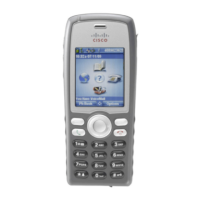Cisco Unified Wireless IP Phone 7925G Series Deployment Guide 38
The number of calls may vary depending on the data rate, initial channel utilization, and the environment.
Note: It is highly recommended to use 802.11a if using Bluetooth.
Prior to release 1.3(3), only 2 bi-directional RTP streams were supported when using Coexistence.
Dynamic Transmit Power Control (DTPC)
To successfully exchange packets between the wireless IP phone and the access point, Dynamic Transmit Power Control
(DTPC) should be enabled.
When using an access point that supports DTPC, set the client power to match the local access point power.
Do not use default setting of Max power for client power on Cisco autonomous access points as that will not advertise DTPC to
the client.
If the access point does not support DTPC, then the Cisco Unified Wireless IP Phone 7925G Series will use the highest
available transmit power depending on the current 802.11 mode and data rate.
The transmit power on the Cisco Unified Wireless IP Phone 7925G Series can also optionally be configured to match the
highest transmit power of an access point in the wireless LAN. This setting prevents one-way audio when RF traffic is heard in
one direction only.
By default the Cisco Unified Wireless IP Phone 7925G Series will use the highest available transmit power by default (i.e. 17
dBm / 50 mW for 2.4 GHz and 16 dBm / 40 mW for 5 GHz).
The access point’s radio transmit power should not have a transmit power greater than what the Cisco Unified Wireless IP
Phone 7925G Series can support.

